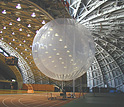 Low energy solar neutrinos have finally been detected. This confirms current theory that neutrinos oscillate between three types on their journey from the sun to earth. From the NSF:
Low energy solar neutrinos have finally been detected. This confirms current theory that neutrinos oscillate between three types on their journey from the sun to earth. From the NSF:An international team of researchers has detected low-energy solar neutrinos--subatomic particles produced in the core of the sun--and measured in real-time the rate the particles hit our planet.
The researchers also obtained fresh evidence that neutrinos oscillate (transform from one state to another) before arriving at Earth, adding weight to present theories about the nature of neutrinos and the inner workings of the sun and other stars.
The team of more than 100 researchers, including National Science Foundation (NSF)-supported investigators at Princeton University and Virginia Tech, have operated the so-called Borexino experiment in one of the deepest laboratories in the world, the Gran Sasso Laboratory of the Istituto Nazionale di Fisica Nucleare (INFN, the Italian National Institute of Nuclear Physics), near the town of L'Aquila, Italy.
These are the first results from the Borexino experiment that has been under construction since the late 1990s with the support of INFN as the lead agency, NSF in the United States, and institutions in Germany, France and Russia.
"In making these first direct measurements of low-energy neutrinos coming from the sun, Borexino represents a convergence of our present understanding of neutrino properties and the physics of solar energy generation," said Brad Keister, program director for nuclear physics in NSF's mathematical and physical sciences directorate.
"The great depth of the laboratory and the incredible purity of the materials used in the detection were critical to the discovery and demonstrated the impact of eliminating background radiation from such experiments," added Keister.
Produced in the Big Bang, and more recently in stars and nuclear reactors, neutrinos are everywhere. They constantly bombard the Earth, but because they interact very weakly, chances are slim a neutrino will hit anything. More than 100,000,000,000,000 pass through each of us every second without our noticing them.
The 18-meter (59-foot) diameter Borexino detector lies more than a kilometer (almost a mile) underground in one of the planet's deepest laboratories. The depth blocks out cosmic rays and other radiation sources that could create additional background signals.
The detector is comprised mainly of concentric layers of radiation shielding. Within an external tank filled with 2,400 tons of water, an enormous stainless steel sphere lies anchored. Within the sphere are two nested nylon vessels, each containing successively purer detector fluids.
Neutrinos knock electrons out of atoms in the detector fluid, and in turn, the electrons generate photons as they travel further through the liquid environment...
The research preprint is now available online at the arXiv server, a leading pre-publication posting site for physics discoveries.
No comments:
Post a Comment
To add a link to text:
<a href="URL">Text</a>